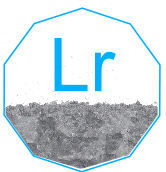Lawrencium

Lawrencium (Lr)
General Information
- Symbol: Lr
- Atomic Number: 103
- Atomic Weight: 262 u (most stable isotope)
- Element Category: Actinide
- Group: N/A (Actinides series)
- Period: 7
- Block: d-block (controversial, sometimes considered f-block)
Physical Properties
- Appearance: Silvery metallic (predicted)
- Density: Unknown (estimated to be around 15.6 g/cm³)
- Melting Point: 1627 °C (2961 °F) (predicted)
- Boiling Point: Unknown
- Phase at STP: Solid
- Electron Configuration: [Rn] 5f¹⁴ 7s² 7p¹ or [Rn] 5f¹⁴ 7s² 6d¹ (controversial)
- Oxidation States: +3 (most stable), +2 (less common)
Chemical Properties
- Reactivity: Lawrencium is highly radioactive and reactive, especially in its +3 oxidation state. It forms compounds with various nonmetals.
- Compounds: Forms compounds such as lawrencium(III) chloride (LrCl₃) and lawrencium(III) oxide (Lr₂O₃).
Uses and Applications
- Scientific Research: Used primarily for research purposes to understand the properties of heavy actinides and transactinides.
Occurrence and Extraction
- Natural Occurrence: Lawrencium does not occur naturally and is a synthetic element.
- Production: Produced in minute quantities in particle accelerators by bombarding lighter actinides such as californium with boron nuclei.
Isotopes
- Stable Isotopes: Lawrencium has no stable isotopes.
- Radioactive Isotopes: The most significant isotopes are Lawrencium-262 (half-life of 3.6 hours), Lawrencium-261 (half-life of 44 minutes), and Lawrencium-260 (half-life of 2.7 minutes).
Safety and Handling
- Hazards: Lawrencium is highly radioactive and poses significant health risks. It can cause radiation poisoning and cancer if inhaled or ingested.
- Precautions: Handle with extreme care, using appropriate protective equipment and working in controlled environments. Proper disposal of radioactive materials is crucial.
History
- Discovery: Discovered by a team of scientists led by Albert Ghiorso at the Lawrence Berkeley National Laboratory in 1961.
- Name Origin: Named after Ernest O. Lawrence, the inventor of the cyclotron and a pioneer in nuclear science.
Additional Facts
- Crystal Structure: Unknown
- Magnetic Properties: Unknown
- Thermal Conductivity: Unknown
- Electrical Resistivity: Unknown
Summary
Lawrencium is a synthetic, highly radioactive element used primarily for research purposes. Discovered in 1961, it is produced in extremely small quantities in particle accelerators. Lawrencium requires careful handling due to its high radioactivity.
40 Question and Answer Pairs About Lawrencium
What is the atomic number of Lawrencium?
- 103
What is the symbol for Lawrencium?
- Lr
What is the atomic weight of Lawrencium’s most stable isotope?
- 262 u
In which group of the periodic table is Lawrencium found?
- Actinides series (no specific group)
What period is Lawrencium in?
- Period 7
What block does Lawrencium belong to?
- d-block (controversial, sometimes considered f-block)
What is the estimated density of Lawrencium?
- Around 15.6 g/cm³
What is the melting point of Lawrencium?
- 1627 °C (2961 °F) (predicted)
What is the boiling point of Lawrencium?
- Unknown
What is the electron configuration of Lawrencium?
- [Rn] 5f¹⁴ 7s² 7p¹ or [Rn] 5f¹⁴ 7s² 6d¹ (controversial)
What are the common oxidation states of Lawrencium?
- +3 (most stable), +2 (less common)
What is the predicted appearance of Lawrencium?
- Silvery metallic
Is Lawrencium reactive with air?
- Yes, it forms compounds with various nonmetals.
Name a common compound of Lawrencium.
- Lawrencium(III) chloride (LrCl₃)
What is a common use of Lawrencium in research?
- To study the properties of heavy actinides and transactinides.
How is Lawrencium typically produced?
- By bombarding lighter actinides such as californium with boron nuclei in particle accelerators.
What is the most common isotope of Lawrencium used in research?
- Lawrencium-262
How is Lawrencium extracted?
- Produced synthetically in minute quantities in particle accelerators.
What safety hazard is associated with Lawrencium dust?
- It is highly radioactive and poses significant health risks.
Who discovered Lawrencium?
- A team of scientists led by Albert Ghiorso at the Lawrence Berkeley National Laboratory.
Where does the name Lawrencium come from?
- Named after Ernest O. Lawrence, the inventor of the cyclotron.
What is the crystal structure of Lawrencium at room temperature?
- Unknown
Is Lawrencium paramagnetic or diamagnetic at room temperature?
- Unknown
What is the thermal conductivity of Lawrencium?
- Unknown
What is the electrical resistivity of Lawrencium?
- Unknown
What is the primary oxidation state of Lawrencium in its compounds?
- +3
Is Lawrencium found as a free element in nature?
- No, it is a synthetic element.
What is the common name of Lawrencium(III) chloride?
- LrCl₃
What is a major application of Lawrencium in scientific research?
- Studying the properties of heavy actinides and transactinides.
How does Lawrencium benefit isotope production?
- Used to study and produce other heavy elements.
What is the melting point of Lawrencium in Kelvin?
- 1900 K (predicted)
What group does Lawrencium belong to in the periodic table?
- Actinides series
What is the natural abundance of Lawrencium-262?
- It is produced synthetically and is not found naturally.
Can Lawrencium be used in high-temperature applications?
- Yes, but its primary use is in research.
What is the key property that makes Lawrencium valuable in research?
- Its radioactive properties and role in studying heavy actinides.
How is Lawrencium used in the chemical industry?
- Mainly in research and specialized applications.
What precautions should be taken when handling Lawrencium?
- Use appropriate protective equipment to avoid inhalation or ingestion.
What are the health risks associated with Lawrencium?
- It can cause radiation poisoning and cancer if inhaled or ingested.
What are the common isotopes of Lawrencium used in research?
- Lawrencium-262, Lawrencium-261, and Lawrencium-260.
What is the primary challenge in studying Lawrencium?
- Its high radioactivity and short half-life.






